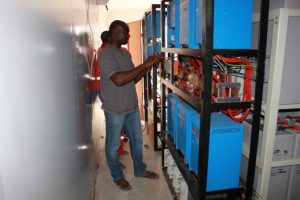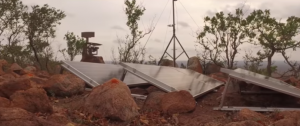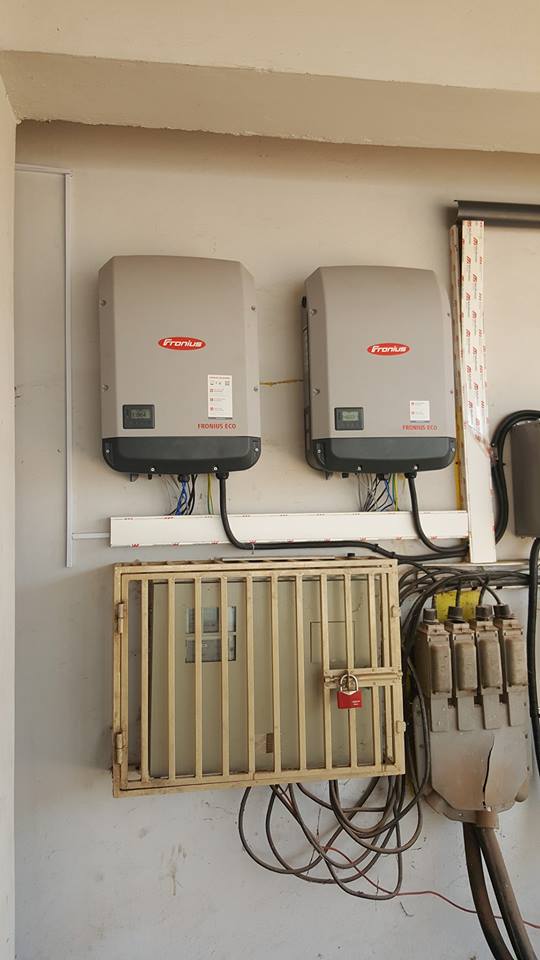Lithium-ion batteries in Renewable energy resources – such as wind, water or solar solutions – hold great promise. They could provide energy while overcoming Africa’s infrastructural challenges. But this energy would still need to be stored. Lithium-ion batteries might provide a solution. The Conversation Africa asked Bernard Jan Bladergroen about the challenges and opportunities.
What are lithium-ion batteries and what are its benefits?
Lithium ion, or Li-ion, batteries are a type of rechargeable battery. They are a popular choice because when well looked after, they can be drained and charged literally thousands of times which makes them superior to commonly used lead acid batteries.
Lithium-ion batteries – like other batteries used to store energy – act as a buffer between power generation and consumption. The batteries are charged when power is available from, example, a wind turbine, solar panels or the grid, and then provide power when it’s not.
If Lithium-ion batteries could be manufactured in Africa, on the appropriate scale, they would become cheaper and power users could rely more on renewable energy than they do now. This would open the path for clean, sustainable energy, mitigating the effects of climate change. It could also boost economies.
Africa already has part of the solution: photovoltaic (PV) panels are common and the energy they produce in South Africa is approximately 40% cheaper than that generated from fossil or nuclear fueled power stations. The main drawback of PV power is that it can only really be generated between 5-7 hours daily (depending on what part of the continent one is located. That’s not when most people need to use it, so it has to be stored cheaply.
Lithium-ion batteries have been commercialized elsewhere in the world. Why not in Africa yet?
Li-ion batteries are used in many commercially available products, like power tools, toys, electric bikes, laptops and mobile phones. Large Li-ion battery packs in home and grid-power applications are becoming rapidly more popular in many countries, including Africa.
There are only a few Li-ion battery factories in the US, Poland, South Korea, Japan and China. Most of the companies that run them work closely with electric vehicle manufacturers and consumer good production sites. Some of the top 10 companies manufacturing the batteries include; Panasonic, Toshiba, Samsung SDI, LG-Chem and Tesla.
There are a few small companies in South Africa who assemble battery packs using imported cells. And, to the best knowledge of the author, there’s only one facility on the African continent that has the capability to produce Li-ion battery cells at pilot scale: the University of the Western Cape’s Energy Storage Innovation Lab. The lab has already been laying the groundwork for industrial Li-ion batteries assembly. Though I cannot say with certainty that Li-ion cells are not being produced elsewhere in Africa, it would be hard for a commercial plant to go unnoticed as it would have to be very large to be profitable.

freedom won lithium-ion battery installed in Accra
There is huge opportunity. South Africa has almost 80% of the world’s known reserves of manganese – an important component of the most popular battery. Because the companies that produce Li-on batteries have deep pockets, and because the price of manganese is relatively low, they have been able to import it from South Africa.
A growing market will eventually justify the creation of a local battery production plant. But to produce batteries at a competitive price, a large scale facility with an investment of at least $1 billion is required. Only in a facility that produced millions of excellent quality cells per day would the cost per cell be able to compete with cells produced on other continents. It will be challenging to raise the required capital in Africa.
What would be the major challenges in commercializing Li-ion across the continent?
To achieve commercialization across the continent, the cost of a Li-ion battery system needs to be lower than any alternative energy storage system. Currently, Li-ion batteries cost between $500-$1000/kWh, significantly more than Lead Acid batteries, but since they last much longer than Lead Acid, they can offer a better deal.
The desired shift away from our unsustainable fossil-fuel-based economy can be realized when we produce Li-ion batteries that last many years and cost as little as $300/kWh. Economy of scale is crucial to achieve these costs.
The electrification gains could be huge. Renewable energy – such as wind or solar solutions – combined with an energy storage device that could deliver electricity at the cost of electricity from a power station would be a game changer. And because Africa’s power distribution network is still underdeveloped, investors in the device could see returns sooner than in regions with a fully developed transmission network that’s already paid for.






 If you are a state broadcaster, Fiji is a difficult region.It takes Victron Energy to power Digital TV in Fiji
If you are a state broadcaster, Fiji is a difficult region.It takes Victron Energy to power Digital TV in Fiji



 Education and Grid electricity can’t be taken for granted when you happen to live in one of the most sparsely populated countries on the planet. If you live in the rural part of any country ‘public services’ like education has a habit of passing you by; but in Botswana – with its half-a-million square kilometers of rural land – most of the country is ‘off grid’. The Government is making one of its biggest investments to make sure children don’t miss out on a modern education…The Ministry of Education and Skills has embarked on an ambitious project to provide 20 rural schools with state of the art off-grid Solar Power plants – each providing an impressive 90 to 150kVA. That’s enough for the School’s pupils, office block, kitchen and up to 10 associated ‘staff houses’. A micro-grid.
Education and Grid electricity can’t be taken for granted when you happen to live in one of the most sparsely populated countries on the planet. If you live in the rural part of any country ‘public services’ like education has a habit of passing you by; but in Botswana – with its half-a-million square kilometers of rural land – most of the country is ‘off grid’. The Government is making one of its biggest investments to make sure children don’t miss out on a modern education…The Ministry of Education and Skills has embarked on an ambitious project to provide 20 rural schools with state of the art off-grid Solar Power plants – each providing an impressive 90 to 150kVA. That’s enough for the School’s pupils, office block, kitchen and up to 10 associated ‘staff houses’. A micro-grid. The government recognizes the importance of education and seeks to offer an equal opportunity to all Botswanan children -regardless of whether they grow up in the city – or remotely. No electricity means no computers – and without learning computer skills a child becomes part of a lost generation …unable to reach his/her full potential. For that reason the Government have signed off this initiative which represents one of their biggest, newest investments.
The government recognizes the importance of education and seeks to offer an equal opportunity to all Botswanan children -regardless of whether they grow up in the city – or remotely. No electricity means no computers – and without learning computer skills a child becomes part of a lost generation …unable to reach his/her full potential. For that reason the Government have signed off this initiative which represents one of their biggest, newest investments. A long way from the cities, sophistication of these electronic installations is an unfamiliar sight – but no short-cuts have been made in guaranteeing the future of electricity provision, with state of the art power plants which may comprise of up to 12 Inverters 48V
A long way from the cities, sophistication of these electronic installations is an unfamiliar sight – but no short-cuts have been made in guaranteeing the future of electricity provision, with state of the art power plants which may comprise of up to 12 Inverters 48V  Now the very latest technology is available to these children as an educational tool. No matter that their school is far out of town, increasingly rural children can enjoy the same advantages as children in the cities.By taking a long-term view the power needs of remote schools, villages – even towns – can be met through installing Solar Powered Micro-Grids. The power used by these far-sighted schemes is cleaner; uses less infrastructure; is more easily maintained; and is more secure from acts of god …or civil unrest. Not only that, they have their costs under control …and the price they pay for their power, over the lifetime of the installation is a fraction of the price paid by those of us who are grid-connected.
Now the very latest technology is available to these children as an educational tool. No matter that their school is far out of town, increasingly rural children can enjoy the same advantages as children in the cities.By taking a long-term view the power needs of remote schools, villages – even towns – can be met through installing Solar Powered Micro-Grids. The power used by these far-sighted schemes is cleaner; uses less infrastructure; is more easily maintained; and is more secure from acts of god …or civil unrest. Not only that, they have their costs under control …and the price they pay for their power, over the lifetime of the installation is a fraction of the price paid by those of us who are grid-connected. Think about this: In the UK the average annual bill for electricity today is £600. The average annual electricity price-rise is 8%. In 25 years time (the lifetime of a solar panel) the average annual bill for electricity will be £4,100. The economic argument for generating your own electricity from Solar Power has been won – it’s cheaper.In many ways – the Botswanan Government, and Botswanan schoolchildren are showing us the way ahead.
Think about this: In the UK the average annual bill for electricity today is £600. The average annual electricity price-rise is 8%. In 25 years time (the lifetime of a solar panel) the average annual bill for electricity will be £4,100. The economic argument for generating your own electricity from Solar Power has been won – it’s cheaper.In many ways – the Botswanan Government, and Botswanan schoolchildren are showing us the way ahead.
 Financed mainly by charitable donations the surveillance installations are highly mobile, frequently moved, and can be packed for deployment by truck – or even slung under a helicopter and flown-in to new surveillance sites.
Financed mainly by charitable donations the surveillance installations are highly mobile, frequently moved, and can be packed for deployment by truck – or even slung under a helicopter and flown-in to new surveillance sites.
 As the solar inverter industry is becoming more commodified every year, inverter spec sheets are starting to look a lot more similar. Many inverter capabilities are driven by the same market requests and NEC code regulations, making features and pricing very similar across all inverter brands in the market. Therefore, a buyer could think that the only thing to look at is the price tag. However, it’s crucial to actually look past the spec sheet and the initial purchase price. When picking an inverter, you not only chose a piece of equipment, you are choosing a partner to work with for the next 20+ years. Thus, you might want to look into more than just “the box” and its price.
As the solar inverter industry is becoming more commodified every year, inverter spec sheets are starting to look a lot more similar. Many inverter capabilities are driven by the same market requests and NEC code regulations, making features and pricing very similar across all inverter brands in the market. Therefore, a buyer could think that the only thing to look at is the price tag. However, it’s crucial to actually look past the spec sheet and the initial purchase price. When picking an inverter, you not only chose a piece of equipment, you are choosing a partner to work with for the next 20+ years. Thus, you might want to look into more than just “the box” and its price.





